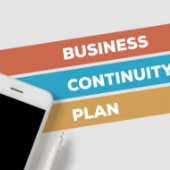 With the COVID-19 pandemic, many business owners are cutting costs and jeopardizing their organization’s efficiency as a result. If you want to avoid this outcome, you should invest in cloud technology. The cloud will not just help you save money, but it will also help your business run more efficiently.
With the COVID-19 pandemic, many business owners are cutting costs and jeopardizing their organization’s efficiency as a result. If you want to avoid this outcome, you should invest in cloud technology. The cloud will not just help you save money, but it will also help your business run more efficiently.
Ensuring continuity and efficiency with the cloud
The need to stay at home and practice social distancing have changed the way many businesses operate. With their employees unable to come to the office, organizations are forced to function with a remote team whose members are often miles away from each other.
This is where cloud technology helps. When you migrate your data to the cloud, your files are stored in a centralized server that can be accessed via the internet. So as long as a user has an internet-connected device (like a smartphone or laptop) and has the right login credentials, they can access these files from any location.
The cloud also allows multiple users to work on a single file at the same time. Any change to the file is seen in real-time, which makes it feel like team members are collaborating in the same room.
Moreover, with cloud-based communication tools like Slack, your team can communicate with each other through chat, voice calls, and video conferencing. By incorporating these technologies into your processes, your organization can function efficiently while following social distancing protocols.
Saving money with the cloud
Suddenly adopting a remote work setup after years of strictly on-site operations can take a lot of getting used to. One of the most difficult parts of transitioning is making sure you and your staff have the right hardware and software to perform work-related tasks.
Instead of buying hardware with company funds and issuing these machines to your staff, you can have them use their personal laptop computers and mobile devices instead. With this tactic, however, you’re not sure if your employees’ devices have the appropriate specifications to handle their workload.
If you use special software, you may also have to buy and install them on your staff’s personal devices. In short, whether you issue computers or adopt a bring your own device approach, you’re bound to spend a lot of money to facilitate remote work.
But with cloud computing, you won’t need to buy new hardware. You can host your applications on the cloud, enabling a user to run them through a web browser even if they are not installed in his or her device. And because hosted applications use the cloud provider’s resources, they don’t strain user’s devices and can be used even with older or lower-end computers.
Furthermore, hosting applications on the cloud eliminates the need to install programs in each of your staff’s devices. This is particularly helpful if the software you use has a limit on the number of devices it can be installed on. This way, you save money by not having to invest in newer devices for your staff and wasting time locally downloading the software.
Should you migrate to the cloud now?
The short answer is yes. Thanks to the COVID-19 lockdowns, the ability to work remotely has now become essential to a business’s survival. And the cloud easily facilitates a remote work environment.
See for yourself how the cloud lets you continue doing business even in the middle of a pandemic. Contact us today to get started!

 Many businesses have been severely affected by the COVID-19 pandemic. If you want your business to survive and maintain its operational efficiency, then you need to invest in the right technology. Investing in the cloud will ensure business continuity while helping you save money.
Many businesses have been severely affected by the COVID-19 pandemic. If you want your business to survive and maintain its operational efficiency, then you need to invest in the right technology. Investing in the cloud will ensure business continuity while helping you save money. With the COVID-19 lockdowns forcing most economic sectors to slow down, cloud technology can help your business survive and remain competitive. More specifically, you can cut costs and increase operational efficiency using the cloud.
With the COVID-19 lockdowns forcing most economic sectors to slow down, cloud technology can help your business survive and remain competitive. More specifically, you can cut costs and increase operational efficiency using the cloud. Many small- to medium-sized business (SMB) owners never expect a major crisis to hit their company and are often caught flat-footed when it does. Such events can cause downtime, which can lead to lost revenue and reduced profits. In addition, SMBs that fail to recover quickly from disruption face the risk of losing their customers to their competitors. To prevent this from happening to you, you should have a BCP in place.
Many small- to medium-sized business (SMB) owners never expect a major crisis to hit their company and are often caught flat-footed when it does. Such events can cause downtime, which can lead to lost revenue and reduced profits. In addition, SMBs that fail to recover quickly from disruption face the risk of losing their customers to their competitors. To prevent this from happening to you, you should have a BCP in place. Do you know why some small- to medium-sized businesses (SMBs) succeed while others fail during the first five years of operation? Poor leadership is one reason, the lack of capital is another. Another big reason is they didn’t prepare for major disruptions, such as natural disasters and cyberattacks, that can bring their business to a grinding halt. This is why you need a BCP.
Do you know why some small- to medium-sized businesses (SMBs) succeed while others fail during the first five years of operation? Poor leadership is one reason, the lack of capital is another. Another big reason is they didn’t prepare for major disruptions, such as natural disasters and cyberattacks, that can bring their business to a grinding halt. This is why you need a BCP.
 Businesses across the globe have been hit hard by the COVID-19 pandemic. Many have been forced to close their doors, some only temporarily, but countless others for good. With experts saying there’s no guarantee of a rapid economic recovery, it’s important that you reassess and redefine your business strategy and buckle down for more storms ahead. Here are some tips to help your business survive this crisis and come out on top.
Businesses across the globe have been hit hard by the COVID-19 pandemic. Many have been forced to close their doors, some only temporarily, but countless others for good. With experts saying there’s no guarantee of a rapid economic recovery, it’s important that you reassess and redefine your business strategy and buckle down for more storms ahead. Here are some tips to help your business survive this crisis and come out on top. More than being a global health crisis, the COVID-19 pandemic is also upending the global economy. Many businesses find themselves facing the grim reality that if they don’t find a way to adapt to the crisis, they’ll end up closing their doors for good. Here are some tips that can help your business get through these tough times.
More than being a global health crisis, the COVID-19 pandemic is also upending the global economy. Many businesses find themselves facing the grim reality that if they don’t find a way to adapt to the crisis, they’ll end up closing their doors for good. Here are some tips that can help your business get through these tough times. As the coronavirus disease continues to spread all over the world, more and more businesses are faced with a difficult decision: find a way to adapt to the current situation or close their doors forever. Here are some tips to help your business adjust to the challenges of the pandemic and stay afloat during these tough times.
As the coronavirus disease continues to spread all over the world, more and more businesses are faced with a difficult decision: find a way to adapt to the current situation or close their doors forever. Here are some tips to help your business adjust to the challenges of the pandemic and stay afloat during these tough times. Business continuity is often overlooked until it’s too late. But with the cloud on their side, IT departments and business owners can more easily adopt this strategy to help avert the next outage. Here’s how the cloud benefits implementations of business continuity.
Business continuity is often overlooked until it’s too late. But with the cloud on their side, IT departments and business owners can more easily adopt this strategy to help avert the next outage. Here’s how the cloud benefits implementations of business continuity. Unforeseen disasters can strike at any time, and when they do, your business could come to a grinding halt. Having a business continuity plan could prevent this from happening by securing your valuable business data at another location. But all too often, data backup can be too complicated for the average IT personnel to manage. Should you get hit by a disaster or a data breach, a lack of proper data backup could mean the end of your business — all the more reason to integrate cloud hosting in your data backup strategies. Here’s why the cloud is better than internal backups.
Unforeseen disasters can strike at any time, and when they do, your business could come to a grinding halt. Having a business continuity plan could prevent this from happening by securing your valuable business data at another location. But all too often, data backup can be too complicated for the average IT personnel to manage. Should you get hit by a disaster or a data breach, a lack of proper data backup could mean the end of your business — all the more reason to integrate cloud hosting in your data backup strategies. Here’s why the cloud is better than internal backups. Are you weighing the pros and cons of the cloud for business continuity? Let’s take a closer look at why the cloud is best for this strategy.
Are you weighing the pros and cons of the cloud for business continuity? Let’s take a closer look at why the cloud is best for this strategy.